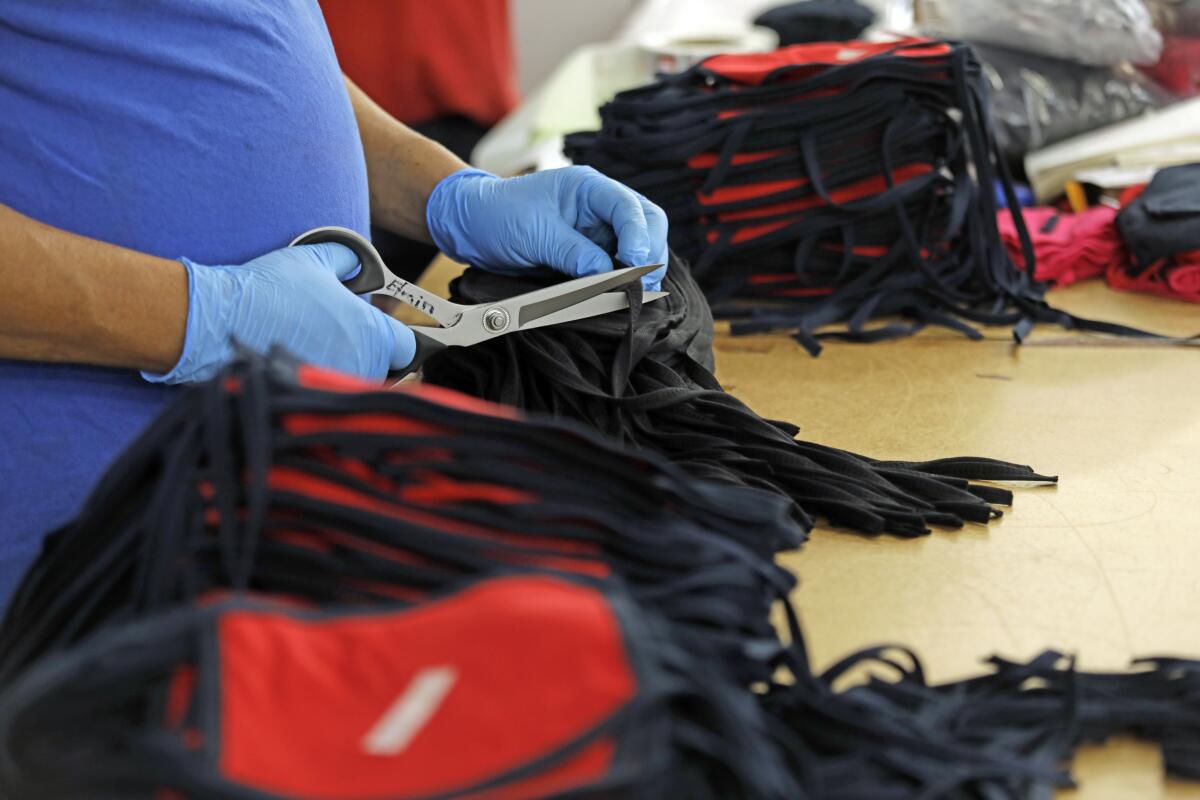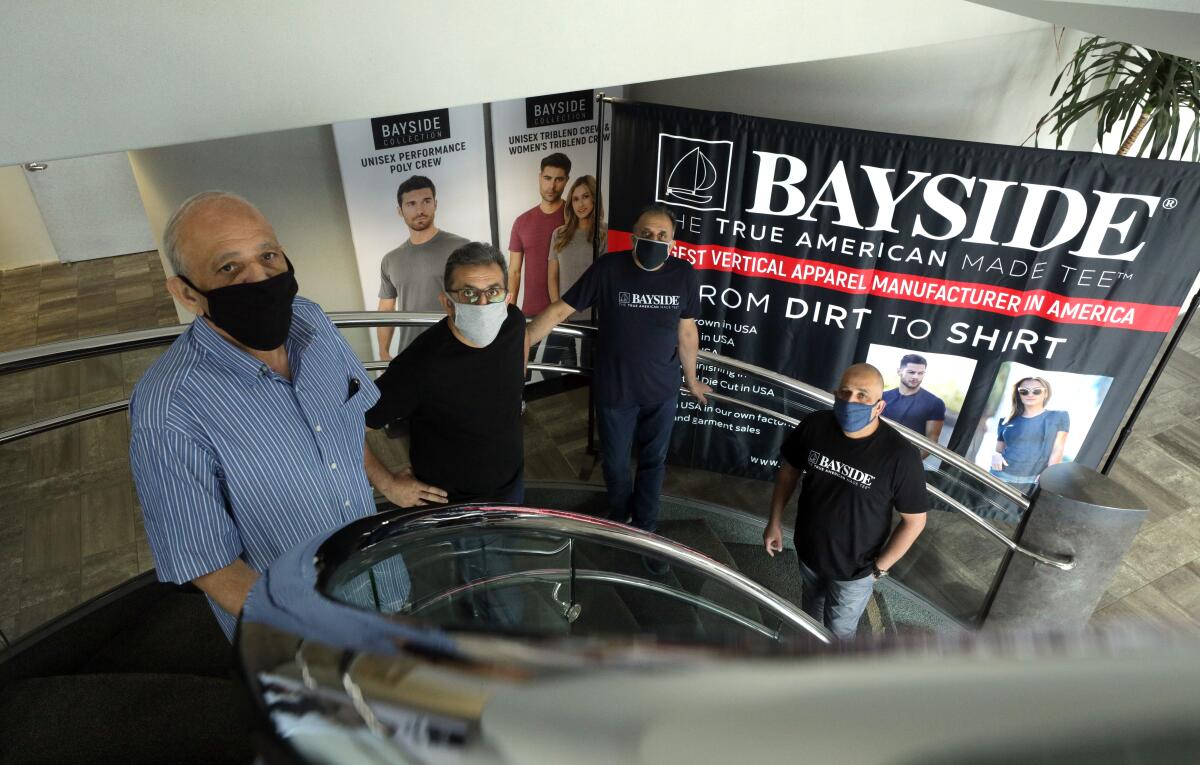How the L.A. apparel industry became mask makers

- Share via
Abdul Rashid Dadabhoy knew he had a critical problem when Orange County supervisors shut down all nonessential businesses on March 17 in response to the coronavirus, forcing him to halt production at AST Sportswear, one of the nation’s biggest makers of T-shirts.
But he also had a nearly instantaneous solution.
After hearing of the critical shortage of face masks, Dadabhoy sat down with his three brothers the next morning and prototyped a cotton version, which workers at the company’s vertically integrated Brea factory churned out 1,200 pieces of the next day. The company has made more than 10 million masks since.
“We kept doing that and we are still doing that,” said Dadabhoy, chief operating officer of the family-owned business, which prides itself on its “Made in the USA” label and ability to fill orders faster than its overseas competition.
Indeed, demand isn’t expected to wane anytime soon, especially now that Gov. Gavin Newsom issued an order Thursday making masks mandatory in most public settings.
The virus outbreak has slashed trade and devastated the economy, but it’s also provided opportunities to some companies and industries that have maintained supply chains and production close to home — and a prime example is Southern California’s shrunken but still vibrant apparel industry.
While other sectors remained closed for months, Southern California’s apparel manufacturers, which employ thousands, turned on a dime to produce masks and other critically needed personal protective equipment. This nimbleness allowed local businesses to compete with low-cost overseas suppliers, but it also exposed employees to possible infection and reignited allegations that its low-income, largely immigrant workforce was being exploited.
More than 400 apparel companies have participated in L.A. Mayor Eric Garcetti’s LA Protects initiative to produce 5 million masks, which is open to Los Angeles city and county businesses. AST joined a national PPE consortium of large apparel makers that includes Los Angeles Apparel and big outfits such as Hanesbrands.

The initiatives are highlighting the advantages of a domestic industry that is still standing even though it has been battered over the last several decades by the growth of international trade, including through the North American Free Trade Agreement in 1994 and China’s entrance into the World Trade Organization in 2001.
By one estimate, employment in the L.A. apparel industry has shrunk since the early 1990s from roughly 150,000 to just 45,000 today as leading brands moved production out of the country to take advantage of lower labor costs in Mexico, Central America and Asia. Yet Los Angeles remains one of the country’s top fashion centers, now defined by trendsetters such as Revolve and Fashion Nova, e-commerce businesses that have experienced skyrocketing growth off a vast base of Instagram influencers.
It’s a segment of the industry where responding to rapid changes in taste is paramount, and where local production can give an edge over foreign factories with lengthy supply chains — and potential quality-control problems, something recently highlighted by Chinese mask imports.
One company that began making masks and other PPE is Lefty Production Co., a “one-stop” vertically-integrated shop that provides design consultation, pattern-making, cutting, sewing and other services to smaller brands. It was co-founded by Marta Miller and partner Emily Roiff in 2012, after realizing that up-and-coming designers needed help getting their clothes made locally.
“We don’t knit the fabric, but besides that part of the supply chain we have everybody in one team under one roof doing all that,” Miller said.
Lefty Production serves nearly 100 smaller designers who sell direct-to-consumer online or wholesale and want a batch of 300 to 10,000 articles of clothing — the kind of order that large-volume Asian factories either don’t handle or for which they might charge too much.
“As their volume decreases, their prices increase overseas, and so it starts to make less economic sense. My clients want low inventory and quick. Things that overseas can’t do,” Miller said. “I have a client. We cut the same bikini top and bottom in probably a hundred different colors, and each color is like 20 or 30 units.”
When the stay-at-home orders were issued, Miller started serving the medical industry. “Big hospitals. They were ordering overseas and they just weren’t getting their packages, and so they are running out of masks, running out of bouffant caps, running out of shoe covers,” said Miller, who was able to keep her 35 workers employed.
Meanwhile, big fashion brands already struggling from reduced mall traffic and the growth of Instagram-driven online sales, have hit hard times. Preppy stalwart J. Crew, which didn’t have masks for sale on its main website at the end of last week, filed bankruptcy in May after the debt-laden chain was pushed over the edge by the virus-related closures. It followed the bankruptcy filing of mall-based fast-fashion retailer Forever 21 in September, at least partially due to online competition.
Los Angeles Apparel, founded by Dov Charney, who was ousted from his former business, American Apparel, after a tenure marred by allegations of sexual and other misconduct, has grown his new business rapidly through an online, direct-to-consumer sales model since its 2016 founding. He also quickly shifted to making masks.
Los Angeles Apparel makes elevated basics similar to American Apparel, which during Charney’s ownership operated retail stores, knitted its own fabrics, and cut and sewed its clothing at a downtown factory. The new company doesn’t yet knit yarn, but is otherwise vertically integrated at its South L.A. factory complex.
Charney says that while his clothing costs more than an import, that price differential is not important for fashion-conscious shoppers who can afford to buy his $24 T-shirts and $78 pants. What is more critical is the ability to quickly respond to online fashion trends that can rapidly shift.
“What is really important right now is the assembly of the product, to accelerate or decelerate production. No one is saying that Walmart shouldn’t be free to buy in Bangladesh at five cents on the dollar. I am just saying that is one business stream. There is also a multibillion-dollar stream of rapid reaction urban manufacturing,” he said.
Los Angeles Apparel took advantage of that strength in February to start making masks, hospital gowns and other PPE. The company was so busy it hired hundreds of workers and opened two newly leased buildings. Charney says the company now employs 2,000 people.
At AST, Dadabhoy said the company can put a product in a buyer’s hand within four to six weeks of executing a purchase order, about twice as fast as an overseas supplier. By contrast, Levi Strauss & Co., which sources from hundreds of factories around the globe and just a handful in the U.S., just this month announced it has face masks for sale.
AST also has been able to reduce the price differentials — despite paying its workers on average $20 an hour plus benefits — through its vertical integration. In addition to cutting and sewing, it knits and dyes its owns fabric, which eliminates markups through the production process. But for some buyers that is still not enough.

“Retailers push on price points. That’s when they say, ‘I can only sell for this much,’ or they want to make a certain margin. At that point I can’t sell to them because they can buy the same product for half the price as an import,” he said.
Of course, there are hazards to the model, aside from retailers whose primary focus is cost. While keeping production at your doorstep can help minimize supply chain risk, there are no guarantees in the age of the coronavirus.
Los Angeles Apparel has struggled to keep the coronavirus at bay. The company said it was conducting temperature checks, encouraging social distancing and hand washing, and has erected cardboard barriers at individual workstations to try to protect workers. Yet one employee recently died, prompting the company to have workers tested.
“People were very scared at that moment,” said a worker, who sewed masks and asked not to be identified because she immigrated to the United States without documentation. While she tested negative, a woman she was sitting next to tested positive, as did two coworkers she called friends. In all, more than 10 employees tested positive in this month’s outbreak, the company confirmed.
Charney said the company had experienced cases before, and he called the outbreak “alarming,” prompting the company to improve workstation barriers, reemphasize social distancing rules and initiate routine testing of all employees every seven to 10 days. “We are doing everything we can,” he said. “These are scary times.”
He said the factory was inspected by Cal/OSHA and the Los Angeles County Department of Public Health. Officials at Cal/OSHA were unable to immediately comment. Tim Gilman, a public health spokesman, said the department is working with the company to investigate the matter.
The industry has long been plagued by wage theft, and labor advocates say that some factory owners have exploited workers who are making masks and other protective gear, paying them sub-minimum wages in dangerous conditions because they have nowhere else to turn. Los Angeles Apparel pays its workers the city’s $14.25-an-hour minimum wage and a piece-rate bonus that can more than double the hourly rate, according to Charney.
“This is an industry that had workers working in very unsanitary conditions prior to [COVID-19], and we’re seeing a lot of business as usual now,” Marissa Nuncio, director of downtown L.A.’s Garment Worker Center, told The Times in April. “When workers are producing something that is so critically needed, it’s unacceptable that they’re having to continue to work in unsafe conditions and for sweatshop wages.”
Labor advocates say the domestic apparel industry is profitable, but it is not in dispute that Los Angeles factories are under price pressure from foreign competition employing millions of lower-paid workers.
More than 97% of apparel sold to U.S. consumers is manufactured abroad, with about 80% coming from China, Vietnam, Bangladesh and other Asian countries, said Sheng Lu, an associate professor of fashion and apparel studies at the University of Delaware.
Still, the U.S. apparel industry remains substantial, especially in textile production, which is based largely in the Southeast and growing. Textile manufacturing is capital- and technology-intensive, which has allowed the U.S. to become the world’s fourth-largest exporter of cotton, synthetic and other textiles — fabrics that find their way into clothing imported back into this country.
Meanwhile, California has more domestic apparel manufacturers than any other state, accounting for 24% nationally, twice as many as New York, the second leading state, according to an analysis conducted by Lu and another researcher of a federal database, which he noted is not comprehensive.
However, Lu doubts that the pandemic will have a sizable effect in returning overseas production to the U.S., where he agreed that the advantage is speed to market, usually in higher-priced women’s wear that is not price sensitive. “Those labels — ‘Made in the USA’ — are still niche,” he said.
More likely, he said, some apparel companies may decide to source more from Mexico and Central America — where they already ship U.S. textiles for assembly into clothing and there is broad political support due to the recently passed United States–Mexico–Canada Agreement and the 2006 Central American Free Trade Agreement.
“There is no sign that apparel production is coming back to the U.S. in a sizable way,” said Lu, who prepares the U.S. Fashion Industry Assn.’s annual industry study.
Jon Gold, vice president of supply chain and customs policy at the National Retail Federation, said that even before the pandemic, the trade war had prompted apparel and other manufacturers to examine their far-flung supply chains and the risks of relying so heavily on China.
He said the typical response has been to try to diversify to other Asian countries, while he agreed nearshore outsourcing to Mexico or Central America also has been an option.
“There is a reason we have grown as an economy over the decades. There are certain things we don’t make anymore and shouldn’t be making. We are a more highly evolved economy,” he said.
Times staff writer Sam Dean contributed to this article.
More to Read
Inside the business of entertainment
The Wide Shot brings you news, analysis and insights on everything from streaming wars to production — and what it all means for the future.
You may occasionally receive promotional content from the Los Angeles Times.











